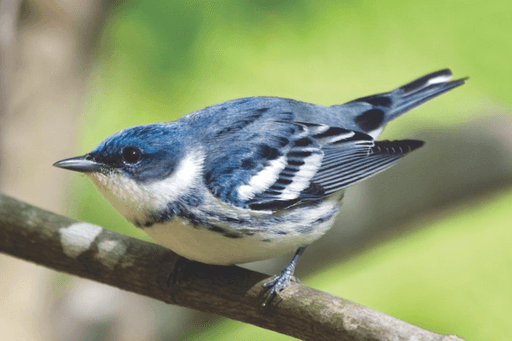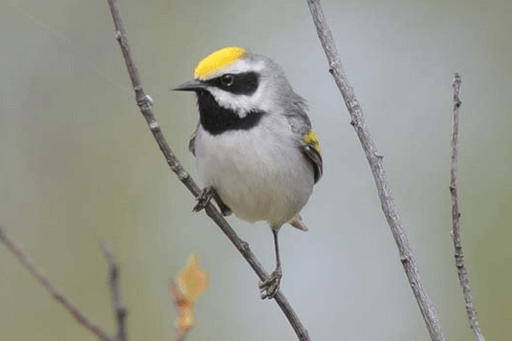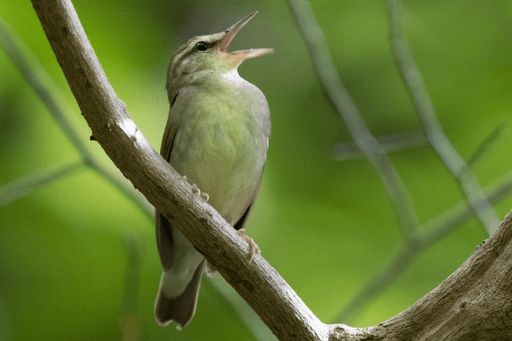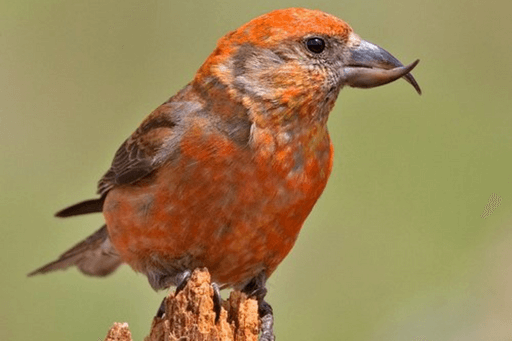Birds of Virginia: Forest Birds
Virginia is a great place to watch birds. The state supports a variety of forest types, including bottomland hardwoods in wet areas and along riparian corridors; pine forests and oak-hickory woodlands in uplands; and conifer forests and mixed broadleaf/coniferous forests on top of mountains. These forests and their various successional stages support a great diversity of birds, including many that are the focus of conservation programs.
This post is part of a five-part series in which we look at some of our favorite bird groups in Virginia (backyard birds, grassland birds, raptors, and waterbirds) by profiling some of the most captivating species in each.
Cerulean Warbler

The Cerulean Warbler winters in the Andes of South America, farther south than most of Virginia's other breeding warblers, and has proportionately longer wings to match this long migration. These warblers often droop their long wings while foraging high in the canopy, which can be a useful field mark when the bird is backlit. The males' buzzy song is part of the forested soundscape of Virginia's mountain slopes and ridge lines in the spring and early summer.
Locations: Cerulean Warblers breed in Virginia's mountains. Look and listen for this species in mature, tall-canopy forest with tree fall and other canopy gaps. Early May is a great time to observe this species: birds arrive on their breeding territories and actively sing to announce their presence, and they are easier to see before trees have fully leafed out. Males sing on territory into July, but this species is one of the earlier wood-warblers to depart breeding grounds; many are on the move by August. The G. Richard Thompson Wildlife Management Area (WMA), Shenandoah National Park, Rapidan WMA, Highland WMA, T.M. Gathright WMA, and George Washington and Jefferson National Forests are all important areas for this species in Virginia. One can also find Ceruleans along the Blue Ridge Parkway and Skyline Drive, and in May, the 14-mile gravel “Warbler Road” at mile marker 78.4 off the Blue Ridge Parkway is highly recommended for viewing up to 20 warbler species!
Conservation: The global Cerulean Warbler population declined 73 percent, to an estimated 570,000 individuals, between 1970 and 2014, and could decline by half again by 2040 if these trends continue. ABC works to reverse this decline by enhancing habitat for Cerulean Warblers through Migratory Bird Joint Ventures and by protecting and restoring habitat with local partners in Latin America where the birds spend northern winters.
About 80 percent of the global Cerulean Warbler population breeds in the Appalachian Mountains. This is one of the focal species of the Appalachian Mountains Joint Venture (AMJV), a regional partnership staffed by five ABC employees that spans portions of Virginia and 11 additional states and consists of more than 55 state and federal agencies, conservation organizations, and universities.
Much of the forested landscape in the Appalachians that was once ideal breeding habitat for Cerulean Warblers now lacks the required diversity of tree species, forest age, and habitat structure, such as natural canopy openings that were once prominent in American Chestnut stands. This is due to degradation from invasive species (plants, insects, and pathogens such as Chestnut Blight), and detrimental historical land-use practices. To improve habitat conditions, the AMJV targets conservation in Focal Landscapes — areas in the region designated as important for priority bird species and other wildlife. One of the six current AMJV Focal Landscapes is located in west-central Virginia, where AMJV partners are working together to restore healthy dynamic forests on private and public lands such as T.M. Gathright, Highland, and Goshen and Little North Mountain WMAs in collaboration with the Virginia Department of Wildlife Resources (DWR).
On the wintering grounds, ABC works with partners to promote shade-grown coffee farming, and to protect natural forests for Cerulean Warblers, including at the Cerulean Warbler Reserve in Colombia with our partner Fundación ProAves, and at the Narupa Reserve in Ecuador with Fundación de Conservación Jocotoco.
Golden-winged Warbler

The Golden-winged Warbler is uncommon in Virginia — and throughout its range. It is sometimes seen during migration in various areas, but in Virginia it only nests in shrubby, high-elevation habitat west of the Blue Ridge Mountains.
Locations: Golden-winged Warblers can be difficult to observe because they tend to be found away from roads. Look for them in shrubby pastures close to forest edges in high-elevation valleys. There is a sizable population in Smyth and Tazewell Counties in southwestern Virginia. In May, look for them where the Appalachian Trail crosses U.S. Forest Service land in Smyth County, just over the Bland County line, as well as in Burke's Garden (also known as “God's Thumbprint”) in Tazewell County. Farther north in the state, one can find breeding Golden-winged Warblers along Wimer Mountain Road in Highland County, just before crossing into West Virginia, including at the Virginia Society of Ornithology's 30-acre Bramble Hill property.
Conservation: The global Golden-winged Warbler population declined 61 percent between 1970 and 2014, to an estimated 400,000 birds. In Virginia and the rest of the Appalachian Region, the population has declined even more sharply — by 90 percent since the 1970s — due to reduction of the species' preferred nesting habitats, young forests and old fields. Over the years, large areas of former habitat have matured, while far less new habitat has been created. Throughout Appalachia, conservation partners now work together in key areas to protect and restore young forests through forest management and restoration practices to benefit Golden-winged Warblers. Golden-wings also face competition from expanding populations of Blue-winged Warblers, with which they hybridize.
Across much of western Virginia, the USDA Natural Resources Conservation Service offers the Working Lands for Wildlife program, which provides financial incentives to private landowners to manage their property for Golden-winged Warbler habitat. More than 60 private landowners in Virginia enrolled 3,400 acres in this program between 2012 and 2020. Participating landowners have implemented or will implement conservation practices that result in increasing young-forest habitat. Landowners interested in participating in this program can contact Chris Peters (Christopher.Peters@usda.gov) to determine if their property meets the general requirements for participation.
Golden-winged Warblers that nest in the Appalachian Mountains winter in northern South America. Forest conversion in South America may be contributing to the decline of this population. ABC works with partners in Central and South America to create conservation plans for this species; to affix geolocator tracking devices to identify migratory stopover sites and to better understand migration routes; and to restore degraded habitat and enhance hundreds of acres of conventional, sun-grown coffee plantations by planting native shade trees.
Prothonotary Warbler

Once known as the Golden Swamp Warbler (perhaps a better name), this yellow bird glows, and is unusual among eastern wood-warblers for nesting in tree cavities and human-provided nest boxes. A migratory species, it arrives in Virginia in April and departs for its wintering grounds in autumn. Recent research at Virginia Commonwealth University used geolocators to identify the Magdalena River Valley of Colombia as perhaps the most important wintering area for Prothonotary Warblers, drawing birds from throughout the species' breeding range.
Locations: During spring and summer, Prothonotary Warblers are widespread in bottomland and riparian woodlands east of the Blue Ridge Mountains, and are found in lower numbers in such habitats in western Virginia. Huntley Meadows Park and Occoquan National Wildlife Refuge, both southwest of Alexandria, are great locations for this species in Northern Virginia, as are various public lands along the James River east and west of Richmond. Great Dismal Swamp National Wildlife Refuge in southeastern Virginia is also a great location to find breeding Prothonotaries. This species has expanded its breeding range farther west in the state, moving inland along Virginia's river corridors. The second Virginia Breeding Bird Atlas documented the most westerly known breeding pair, found using a nest box along the New River south of Pembroke.
Conservation: Although Virginia's Prothonotary Warbler population is stable, the global population declined 38 percent between 1970 and 2014, to an estimated 1.8 million birds. ABC is managing healthy forests as part of the Lower Mississippi Valley Joint Venture, and through the Managed Forests for Birds partnership with the Sustainable Forestry Initiative (SFI) and SFI-certified organizations throughout the Southeast. SFI partners implement bird-friendly forestry practices, such as enhanced streamside buffers and wetland protection, to ensure Prothonotary Warblers have the habitats needed for successful reproduction. On the wintering grounds, ABC supported Fundación Biodiversa in Colombia to expand their El Silencio Reserve by 3,839 acres, including riparian forests where Prothonotary Warblers winter along the Magdalena River.
Swainson's Warbler

Virginia has two separate populations of this hard-to-find, skulking bird of buggy, wet terrain: one in the eastern swamps and the other far to the west, inhabiting Appalachian rhododendron and mountain laurel thickets. Little is known about the connectivity between these disparate groups of Virginia-breeding “Swainy Woo-woos,” including where these birds spend the winter months.
Locations: Great Dismal Swamp National Wildlife Refuge is one of the best and most accessible sites in eastern Virginia to search for Swainson's Warblers. In the southwestern corner of the state, this species shares the dense rhododendron thickets of Breaks Interstate Park with the Hooded Warbler and Louisiana Waterthrush. While it can be hard to spot the Swainson's Warbler in thick understory, this bird's strong, clear song echoes through the Breaks Canyon and high river bluffs. It is difficult to find a more beautiful spot to listen for these cryptic warblers.
Conservation: Swainson's Warbler populations in the U.S. and Canada declined 67 percent, to an estimated 140,000 birds, between 1970 and 2014. In 2021, researchers from the Conservation Management Institute at Virginia Tech tagged 16 Swainson's Warblers with light-level geolocators in Virginia's far-southwestern counties of Buchanan and Dickenson to track where the birds go during migration and winter. Meanwhile, researchers with Virginia Commonwealth University did the same for 14 Swainson's in Virginia's Great Dismal Swamp National Wildlife Refuge. This monitoring is a collaborative project that includes other southern states. Researchers suspect the mountain-nesting Swainson's Warblers migrate to the Yucatán Peninsula in Mexico, while the coastal swamp nesters winter in the Caribbean. The results will clarify where these Virginia forest birds are wintering, and the routes they take. The literature has long associated this species with canebrakes in bottomland hardwoods as primary breeding habitat, but recent research demonstrates that this bird will readily use pine plantations that offer preferred characteristics: nearly complete canopy cover, high stem density, and protective leafy cover from broadleaf saplings, vines, and shrubs. ABC is working with Sustainable Forestry Initiative partners to promote management practices that create these conditions.
Canada Warbler

Also nicknamed the "necklaced warbler," males of this species show a bold necklace pattern of black spots against their yellow breast, while in females this pattern takes the form of a line of gray stripes. Both genders have yellow eye rings. Canada Warblers are most often observed in Virginia as passage migrants headed to or from destinations farther to the north, with most breeding in the boreal forests of Canada, New England, and the Great Lakes region, but some also breed in the mountains of the eastern U.S., including the Appalachians and Blue Ridge Mountains. Here, they are often associated with rhododendron thickets along streams or other wet areas. This striking warbler is a favorite species for Virginia birders to search for on the state's highest peaks and ridges. These migratory birds travel through Central America to spend the winter in cloud forests and coffee farms in the Andes.
Locations: Canada Warblers breed in high-elevation forests, including Mt. Rogers National Recreation Area, Shenandoah National Park, and George Washington and Jefferson National Forests. The dense rhododendron thickets found around the Mountain Lake Lodge (northwest of Blacksburg) are favorite nest sites for breeding Canada Warblers in spring and early summer. During migration, Monticello Park in Alexandria is a great place to view this and other migratory songbirds.
Conservation: Canada Warbler populations declined 63 percent between 1970 and 2014, to an estimated 3 million birds. ABC has been particularly active protecting and restoring habitat for this species on its wintering grounds in the Andes Mountains of South America. Canada Warblers have been observed at 26 different reserves protected by ABC and our partners in the United States and Latin America. In northern Peru alone, ABC has worked with our partner Asociación Ecosistemas Andinos (ECOAN) to protect more than 71,000 acres in multiple reserves, and planted more than 1.3 million trees and shrubs to enhance habitat where Canada Warblers occur.
Rusty Blackbird

Rusty Blackbirds primarily breed in the boreal forests of Canada and Alaska, but winter in swampy woods of the southern United States. In Virginia, they are easiest to find during the winter and on spring migration stopovers from late February to early April. Their vocalizations are reminiscent of the sounds of rusty door hinges, and in some plumages the birds show rusty color in their feathers.
Locations: Rusty Blackbirds winter throughout Virginia. In Northern Virginia, Huntley Meadows Park and Occoquan National Wildlife Refuge are great places to look for them in early spring. The College of William and Mary in Williamsburg is also a fairly reliable site to find flocks of the species numbering up to several dozen birds.
Conservation: The global Rusty Blackbird population declined 89 percent between 1970 and 2014, to an estimated 5.7 million individuals. Restoration and protection of the bottomland forests where this bird winters has been a focus of many Migratory Bird Joint Ventures since their inception in the late 1980s. The Atlantic Coast Joint Venture (which includes much of Virginia) has worked with more than 500 partners to protect, restore, or enhance more than 2 million acres of priority habitats from Maine to Florida, including substantial forested wetlands needed by Rusty Blackbirds for breeding, migration, and wintering. Much is still unknown regarding his bird's mysterious population decline, including the causes and potential ways to reverse it. Hopefully, habitat gains will prove to be a critical contribution to recovering the species.
Red Crossbill

Red Crossbills specialize in eating the seeds of conifers, such as pines and spruces. In North America, they are distributed across coniferous forests of the western mountains, as well as the Appalachians and the boreal forests of the North. In a fascinating story of evolution, there are multiple types of Red Crossbill that differ by their flight calls, bill size, preferred food sources, and their tendencies to wander. Virginia is home to the Appalachian (call type 1) Red Crossbill, which is small-billed and resident in the Appalachian Mountains. During irruption years, influxes of Red Crossbills with other call types occur in Virginia, particularly along the coasts. There is still much to learn about Red Crossbills, and birders who collect and share sound recordings on eBird or iNaturalist can contribute to the growing knowledge of these birds.
Locations: One reliable spot to see Appalachian Red Crossbills in Virginia at any time of year is at the West Virginia border at the top of Briery Branch Road in Rockingham County. Here, crossbills eat grit off the road on the West Virginia side and often perch in trees on the Virginia side. The winter of 2020-2021 was a “superflight” year for irruptive finches in Virginia, including Evening Grosbeaks, Pine Siskins, and Red Crossbills. During this irruption, Sitka Spruce (call type 10) Red Crossbills could be found along the coast in places such as Chincoteague National Wildlife Refuge. Hawk watches are also good places to observe migrating finches, including crossbills.
Conservation: North American Red Crossbill populations declined 12 percent, to an estimated 7.8 million birds, between 1970 and 2014. ABC is partnering with land trusts across Oregon and Washington to protect and restore dry mixed coniferous forests for bird species that rely on these habitats, including the Red Crossbill.
Red-cockaded Woodpecker

The Red-cockaded Woodpecker rarely displays the spot of red on its head for which it is named. A cooperative breeder, this woodpecker lives in what are termed “potential breeding groups” consisting of a breeding pair and multiple helpers. Red-cockaded Woodpeckers are nonmigratory, specialized breeders tied to mature Longleaf and Loblolly Pine savannas in the southern United States. To protect their nests from predators such as Black Ratsnakes, they drill tiny holes in the tree trunk around their nest cavity to allow sap to leak out and dribble down the tree. This interferes with a snake's ability to climb the tree. Over time, this sap can make the tree look like a candle dripping wax. The northernmost breeding populations of Red-cockaded Woodpeckers occur in Virginia. Another southern-pine specialist, the Brown-headed Nuthatch, extends a little farther north into southern Maryland and Delaware, but it is much more widely distributed in pines along Virginia's Coastal Plain.
Locations: Big Woods Wildlife Management Area in Sussex County hosts a breeding group of Red-cockaded Woodpeckers in a well-marked public viewing area, and the Constance Darden Nature Trail at The Nature Conservancy's Piney Grove Preserve, also in Sussex County and open February through October, is another reliable spot. Reintroduced birds at the Great Dismal Swamp National Wildlife Refuge in Suffolk County occur in areas not accessible to the public.
Conservation: Red-cockaded Woodpecker declines prompted its listing as Endangered under the U.S. Endangered Species Act. Aggressive conservation efforts began reversing those downward trends by the mid-1990s, such that population gains over the past two decades led to the species' down-listing to Threatened in 2020. The woodpecker remains listed as State Endangered in Virginia, where, despite significant gains, the population remains relatively small and therefore vulnerable.
Habitat management and provisioning trees with artificial cavities at Piney Grove Preserve are credited with bringing the woodpecker back from a low of two potential breeding groups in 2000 to 15 potential breeding groups in 2020. The total Virginia population numbers just over 100 individuals. Although this population is now self-sustaining, translocations of birds took place from 2000 to 2005 to help bolster the state's numbers. Neighboring Big Woods WMA is being managed as open pine savannah by the Virginia Department of Wildlife Resources and has allowed for the expansion of the Piney Grove population in recent years. Establishment of a second Virginia Red-cockaded Woodpecker population at Great Dismal Swamp National Wildlife Refuge has been ongoing since 2015 via translocations from stable populations in the Carolinas and from Piney Grove.
Perhaps the most promising conservation effort that will ensure that these gains in Red-cockaded Woodpecker populations can be sustained is continued restoration of the Longleaf Pine and other open, frequently burned pine forests. Since 2010, America's Longleaf Restoration Initiative, a collective effort on private and public lands, has resulted in the establishment of 1.3 million acres of Longleaf Pine habitat; 236,000 acres protected; and more than 12 million acres carefully burned to create the open, parklike stands that the Red-cockaded Woodpecker needs. Investments to support Longleaf Pine restoration included the Forestland Stewards program, launched in 2013 with $25 million from ABC's partner International Paper, in partnership with the National Fish and Wildlife Foundation. The result was more than 600,000 acres of native forest conserved, of which 350,000 acres of the Longleaf Pine ecosystem were planted and enhanced. Between 2010 and 2019, the USDA Natural Resources Conservation Service provided approximately $175 million to private landowners who enrolled more than 2.8 million acres into practices specifically to restore and maintain Longleaf Pine ecosystems. Today, there is a total of approximately 4.7 million acres of Longleaf Pine in the Southeast, up from a historic low of 3.2 million acres. This is certainly a positive development for Red-cockaded Woodpeckers.
Common Raven

The Common Raven features prominently in Native American art and lore and is widely regarded for its intelligence. Common Ravens are among the largest songbirds (passerines) in the world. Ranging across the Northern Hemisphere, this adaptable species can be seen soaring like a raptor and scavenging carcasses like a vulture.
Locations: In Virginia, Common Ravens are ubiquitous in the mountains and hills of the western part of the state and have expanded into the Piedmont, even nesting in urban areas.
Conservation: Common Raven populations have increased 168 percent in the United States and Canada, to an estimated 7.7 million birds, between 1970 and 2014, despite risks of disease outbreaks such as West Nile Virus.
We hope you enjoyed this blog post about Virginia forest birds. We recommend the following as additional resources for bird-watching information specific to Virginia:
- Virginia Bird & Wildlife Trail, an organized network of outdoor sites highlighting the best places to see birds and wildlife in the commonwealth.
- Second Virginia Breeding Bird Atlas (eBird Portal) ebird.org/atlasva/home (Note: A free eBird account is required to view these maps/data.)
- Virginia Society of Ornithology www.virginiabirds.org.
- Northern Virginia Bird Club www.nvabc.org.
- Birding Virginia for birding site information with profiles on birding hotspots and counties.
- A Birder's Guide to Virginia, by David W. Johnston, 1999, American Birding Association.
Authors
Daniel Lebbin, Vice President of Threatened Species, American Bird Conservancy; Sergio Harding, Nongame Bird Conservation Biologist, Virginia Department of Wildlife Resources; Ashley Peele, Avian Ecologist, Conservation Management Institute, Department of Fisheries and Wildlife Conservation, Virginia Tech; Becky Keller, Science Coordinator, Appalachian Mountains Joint Venture, American Bird Conservancy; EJ Williams, Vice President, Southeast Region, American Bird Conservancy
Thanks also to Lindsey Troutman, Craig Watson, Ruth Boettcher, Kirsten Luke, Jeff Larkin, Jen Davis, Andrés Anchondo, Peter Dieser, David Wiedenfeld, George Wallace, and the Appalachian Mountains Joint Venture Team (Elizabeth Brewer, Amanda Duren, and Jessica Wise) for their suggestions and edits to this blog series.


















































